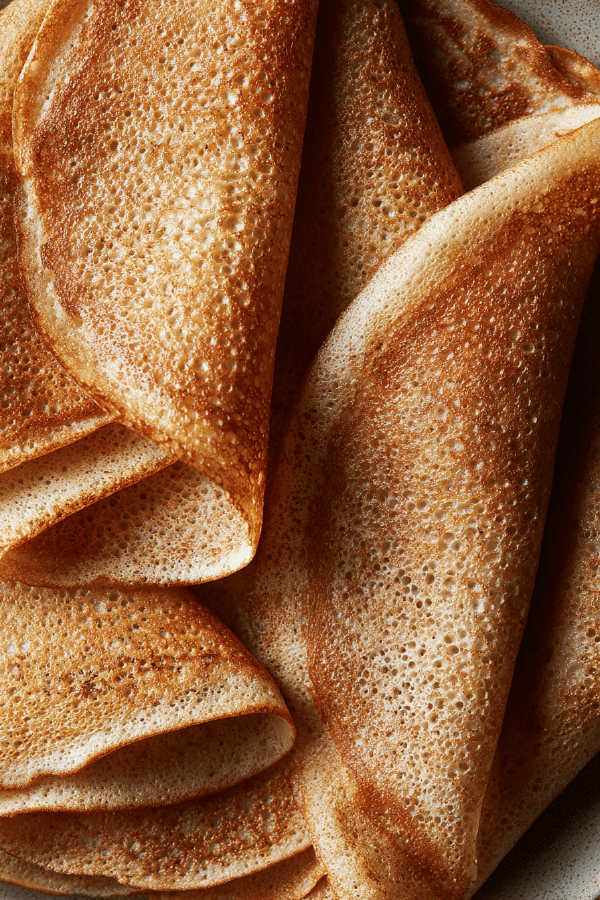Featured Recipe
Basic Crepes Remix

By Kate
"
Light batter flipping fast on a hot pan, subtle golden edges. Uses oat milk instead of regular milk, adds cinnamon and vanilla for a mild twist. Flour cut slightly, replacing some with cornstarch for tender texture. Swaps butter for coconut oil on the pan, keeps them pliable. Watch for bubbling on surface and dry edges before flipping; overcooking dries crepes in seconds. Makes roughly 8 to 9 thin crepes, ideal for stuffing or folding. Substitute eggs with flax for egg-free. The technique hinges on spreading quickly and even heat for thin, lacy edges.
"
Prep:
12 min
Cook:
13 min
Total:
25 min
Serves:
8 crepes
crepes
vegan
breakfast
dessert
dairy-free
Introduction
Crepes demand respect but no fuss. You want thin, pliable sheets, not thick pancakes. Texture matters: quick heat, thin batter, and precise flipping. Oat milk replaces dairy, adds mild sweetness and silkiness without heaviness. Using cornstarch cuts toughness, softens crumb. Cinnamon and vanilla sneak in gentle spices, making crepes ready for anything—from fruit compote to a savory mushroom filling. Timing is sensory-driven; trust your eyes first over the clock. Sound cues too: subtle sizzle, edge lift are your signposts. Avoid tough crepes by resting batter and adjusting heat on the fly. Coconut oil creates a nonstick barrier without smoking or sticking, unlike butter which burns easily. Crepes turn on scent, look, and touch more than numbers. Learn it right, every flip counts.
Ingredients
About the ingredients
Oat milk thickens batter mildly, dairy milk works but often heavier. Maple syrup adds subtle sweetness and depth, swap with agave or sugar if preferred but taste impacts final. Cornstarch is key to tender crepes; skip if unavailable but expect chewier texture. Flour type impacts elasticity—AP flour balances but pastry flour yields more delicate results. Coconut oil tolerates higher heat and resists burning better than butter, but butter gives richer flavor if you don’t mind monitoring heat and possibly frequent pan wipe-downs. Eggs provide structure and moisture; flax seed alternative can be used for egg-free but expect slight difference in flavor and less rise. Pinch of salt highlights flavor; no omission. Vanilla and cinnamon optional but contribute layered aroma, especially when serving sweet. Adjust liquids if batter looks too thick or runny; texture should be pourable but not watery, easy to coat pan thinly without pooling. Resting the batter allows flour to absorb liquid, prevents tough bites. Stir gently before cooking to reincorporate any settled flour without overmixing which develops gluten causing toughness.
Method
Technique Tips
Always preheat the pan thoroughly—cold or uneven heat ruins crepes. Medium-low heat steady and forgiving. Make first crepe a tester; adjust heat or batter thinness. Too thick batter = heavy crepes, too thin = tears. Don’t wait too long before flipping or edges burn; watch for bubbles and dry rims. Flip smart: slide spatula carefully under edge, then flick wrist with confidence to avoid breaking. Second side cooks faster, so only brief contact. Cover cooked crepes loosely—foil traps moisture; paper towel dries out. If crepes stick, wipe pan clean and re-oil, never add batter on sticky surface. Keep pan moving to avoid hotspots; swirl oil between crepes. Whisk batter briefly before each pour, as starch settles. No blender? Sifting flour into bowl then whisking vigorously works fine. If crepes stiffen during stacking, layer with a damp cloth to retain moisture. Reheat gently on pan or steamer to avoid dry cracking. For savory use, skip sugar and cinnamon, add fresh herbs into batter or brush with flavored oil before cooking. Knowing when pan is too hot comes with practice: if batter bubbles furiously and browns unevenly, lower heat. Patience beats speed here.
Chef's Notes
- 💡 Watch batter closely. Too thick? Add a little oat milk. Otherwise, crepes won't thin out. Too runny? Adjust flour next time. Experimenting is key.
- 💡 Heat pan carefully. Cold pan? Trouble. Too hot? You'll burn edges. Medium-low is your friend. Test first crepe for heat clarity. Adjust as needed.
- 💡 Mix well before each pour. Starch likes to settle. No clumps allowed. Clumps lead to uneven cooking. Keep that batter moving, stir, don’t overdo it.
- 💡 Use a sensible oil layer. Less is more with coconut oil. Wipe excess off to avoid grease patches. Dry crepes tear. Lots of small changes add up.
- 💡 Don’t skip batter resting. Ten minutes makes a difference. Hydrates flour; gluten relaxes. Important for tenderness. Crepes yield softer and manageable results.
Kitchen Wisdom
What if crepes stick?
Wipe pan clean and re-oil. Never add to a sticky surface. Hotspots ruin the flow, reheat if necessary.
Can I make it vegan?
Yes, easily. Flaxseed meal works well as egg substitute. Mix one tbsp flax with three tbsp water. Let sit, use it.
Why are my crepes too thick?
Check batter thickness. Adjust with milk to thin. Test-run first crepe helps gauge what's right. Practice matters.
What's best way to store crepes?
Stack with parchment between layers. Cover with damp cloth or foil. Use fridge for few days, freezer longer.



